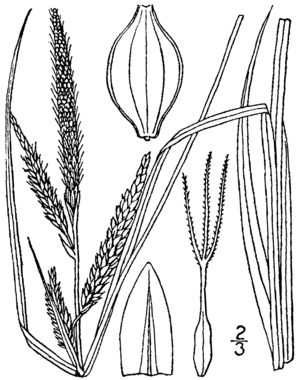Carex barrattii facts for kids
Quick facts for kids Carex barrattii |
|
|---|---|
 |
|
| Scientific classification | |
| Genus: |
Carex
|
| Species: |
barrattii
|
Carex barrattii is a type of plant called a sedge. It is also known as Barratt's sedge. Sedges look a bit like grasses but are different. This special plant grows only in the United States. You can find it along the Atlantic coast, from Connecticut down to Georgia and Alabama. It also lives in the southern Appalachian Mountains.
Contents
About Barratt's Sedge
This section will tell you more about what Barratt's sedge looks like and how it grows.
What Does It Look Like?
Barratt's sedge plants can grow quite tall. Their stems reach from about 20 to 90 centimeters high. That's like a small child to an adult's waist! The leaves are a pale blue-green color. They are only a few millimeters wide.
This plant can produce dark purple flower spikes. But it does not flower very often. Instead, it mostly reproduces in another way. It uses something called a rhizome to make new plants. A rhizome is an underground stem. It helps the plant spread and grow new shoots. This is called vegetative reproduction.
Where Does It Grow?
Barratt's sedge likes wet places. You can find it along wet streambanks. It also grows in open, grassy areas called savannas. Another common home for it is in pine barrens. These are special forests with sandy, acidic soil and lots of pine trees.
A large number of these plants live in the Pine Barrens of New Jersey. This plant prefers sunny spots. It grows best in soils that are acidic.
Plant Neighbors
Barratt's sedge often grows near other plants. Some of its neighbors include:
- Acer rubrum (Red maple trees)
- Chamaedaphne calyculata (Leatherleaf shrubs)
- Clethra alnifolia (Sweet pepperbush)
- Sphagnum mosses
- Spiraea tomentosa (Steeplebush)
- Vaccinium corymbosum (Highbush blueberry)
- Other sedges like Carex stricta and Carex vesicaria
- Scirpus cyperinus (Woolgrass)
Why Is It Important?
This plant needs some help to grow well. It actually needs disturbance. This means things like wildfires. Pine barrens, where it often lives, are places that naturally have fires. These fires help clear out old plants. They also open up the forest floor to sunlight.
Barratt's sedge does not like shade. So, these fires help it get the sunlight it needs to thrive. Without these natural disturbances, the plant might not grow as well.

